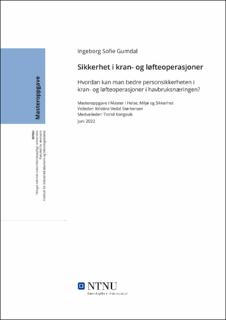| dc.contributor.advisor | Størkersen, Kristine Vedal | |
| dc.contributor.advisor | Kongsvik, Trond | |
| dc.contributor.author | Gumdal, Ingeborg Sofie | |
| dc.date.accessioned | 2022-11-24T18:19:24Z | |
| dc.date.available | 2022-11-24T18:19:24Z | |
| dc.date.issued | 2022 | |
| dc.identifier | no.ntnu:inspera:115572224:115617591 | |
| dc.identifier.uri | https://hdl.handle.net/11250/3033962 | |
| dc.description.abstract | Den norske havbruksnæringen er verdensledende når det kommer til produksjon av atlantisk laks, og næringen står i en utvikling med ny teknologi, større lokaliteter som flyttes lengre til havs, og store volum fisk. Med alle disse løsningene har fokuset tidvis vært å effektivisere driften, og å sikre fiskevelferd. Lenge har utfordringen vært at røkterne setter produksjonen framfor sin egen sikkerhet. Samtidig har antallet alvorlige ulykker de siste årene hatt en økning. Denne studien setter søkelyset på sikkerheten til menneskene som drifter anleggene – røkterne. Kran- og løfteoperasjoner blir utpekt som den største årsaken til dødsfall i tilknytning oppdrettsanlegg. Kran og arbeidsbåt er verktøy som røkterne bruker hver dag, stort sett hele dagen. Kravet til kompetanse står ikke i stil med de risikoene som røkterne står ovenfor daglig, spesielt i tilknytning det ytre miljøet.
Studien går dypere inn i kranoperasjonene, de organisatoriske forholdene rundt driften, og forholdet mellom produksjon og sikkerhet. For å besvare problemstillingen innhentes det data fra dybdeintervju av informanter i tilsynsorgan, HMS-roller og røktere. I diskusjonen anvendes Schiefloes pentagonmodell sammen med sikkerhetsteori og tidligere forskning på sikkerhet i havbruksnæringen, for å konkludere rundt tiltak med bakgrunn i organisatoriske forhold.
Først er det viktig å undersøke hva som er de største risiko og faremomentene i forbindelse med kranoperasjoner. Disse ble identifisert som store operasjoner med innleid personell, bevegelse i underlaget, arbeidspress og håndtering av tunge komponenter. Videre ble det pekt på risiko forbundet med daglig drift og mangel på kompetent arbeidskraft. Man ser at det i det daglige kan skje avvik som over tid blir normalisert. Videre ble røkternes kompetansebehov kartlagt. Dagens krav til kompetanse ble beskrevet som mangelfull og for lav i forhold til risikoene som røkterne utsettes for i det daglige. Det er behov for at opplæringen innebærer stabilitet og forhold knyttet til det ytre miljøet.
Avsluttende legges det fram noen forslag på tiltak som kan forbedre personsikkerheten i kran- og løfteoperasjoner. Disse går på vurdering av risiko, prosedyrer, kompetansekrav, teknologiske forhold og forhold til ytre miljø. En standard som tar for seg disse tiltakene, og som tar røkternes sikkerhet på alvor, vil være ideelt. | |
| dc.description.abstract | The Norwegian aquaculture industry is world-leading when it comes to produced Atlantic salmon, and the industry is in a development with new technology, larger facilities further out at sea, and large volumes of fish. With all these solutions, the focus has occasionally been on efficiency in operations and ensuring fish welfare. For a long time, operators have struggled to put production before their own safety. At the same time, the number of serious accidents has increased during these last years. This study puts the spotlight on the safety of the people who run the facilities - the operators. Crane and lifting operations are identified as the leading cause of death in connection with fish farms. Cranes and operating boats are tools that operators use every day, most of the day. The requirement for competence is not in line with the risks that operators face daily, especially in connection with the weather conditions.
The study takes a deep-dive in the crane operations, the organizational conditions concerning the operation, and the balance between production and safety. To answer the research question, data is obtained from in-depth interviews of informants in supervisory roles, HSE roles and operators. In the discussion, Schiefloe's pentagon model is used in combination with safety theory and previous research on the field of safety in the aquaculture industry, to conclude about measures based on organizational conditions.
First, it is important to examine what are the biggest risks and dangers associated with crane operations. These were identified as large operations with hired personnel, movement in the surface, work pressure and handling of heavy components. Furthermore, the risks associated with daily operations and lack of competent labour were pointed out. It is seen that deviations can occur on a daily basis that are normalized over time. Furthermore, the operators' competence needs were mapped. Today's requirements for competence were described as deficient and too low in relation to the risks to which the operatprs are exposed to. There is a need for the training to involve skills concerning stability and conditions related to the weather conditions.
Finally, some proposals are put forward for measures that can improve personal safety in crane and lifting operations. These account for assessment of risk, procedures, competence requirements, technological conditions, and conditions to the weather conditions. A standard that addresses these measures, and that takes the safety of operators seriously, would be ideal. | |
| dc.language | nob | |
| dc.publisher | NTNU | |
| dc.title | Sikkerhet i kran- og løfteoperasjoner i havbruksnæringen | |
| dc.type | Master thesis | |
